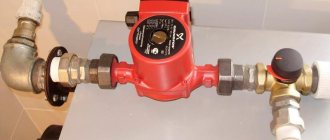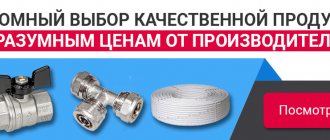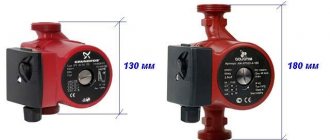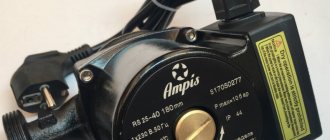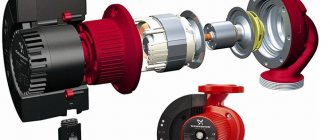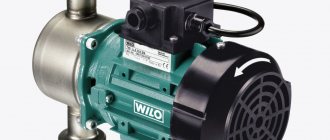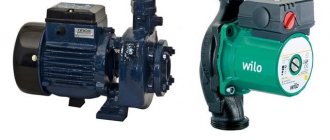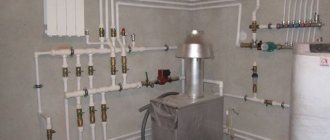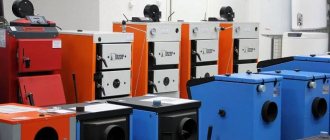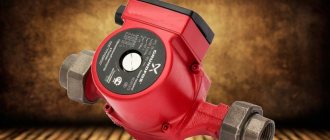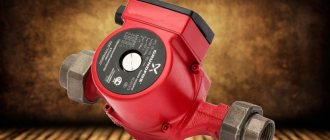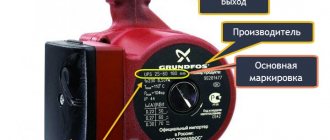With a “dry” or “wet” rotor?
Which circulation pump is better to install for heating: with a “dry” or “wet” rotor? The answer will be given by considering the design and characteristics of each device. Pumps with a “dry” rotor are units in which only the impeller is located in the water. The rotor itself is separated from the water by sealing rings. Such devices have their pros and cons in terms of domestic use.
Advantages of “dry” pumps:
- High efficiency . The efficiency of such devices is 80 - 85%, which is much higher than that of devices with “wet” rotors. Due to their reduced energy consumption, they are advantageous for use in systems with a total pipeline length of over 200 m.
- Working with high temperatures . The temperature of the pumped liquids can be about 110 - 115°.
Disadvantages of “dry” pumps:
- High price . Such units themselves are quite expensive to purchase and maintain.
- Regular replacement of O-rings . On average, the service life of seals is about 3 years, after which they will have to be replaced. The more solid particles there are in the pumped liquid, the shorter the seals will last.
- High noise level . Due to their design features, “dry” models are very noisy, so they will have to be placed in separate rooms (ideally) or in the basement.
It can be said that dry pumps are more suitable for industrial applications where it is necessary to create high pressure and pump liquids through a pipeline of several hundred meters. Some dacha owners install similar units for themselves, connecting the heating system of the house with a workshop, garage or outbuilding. However, if all your heating is less than 200 m, then “dry” models are not relevant for you.
In “wet” pumps, the rotor is in direct contact with water, so only horizontal installation is possible for them. All the filling is enclosed in a metal glass (body).
Advantages of “wet” pumps:
- Low cost . The cost of such units is significantly lower than that of “dry” ones.
- Does not require constant maintenance . Although these pumps can still fail for some reason, they do not require scheduled maintenance, such as “dry” ones, where the seals need to be changed regularly.
- Quiet at work . Due to the fact that the rotor is located in the coolant, its operation is quite quiet, so it will not wake up the apartment residents. It does not require a separate room.
Disadvantages of “wet” pumps:
- Low efficiency . The efficiency of such devices is approximately 50 - 55%, so they are applicable only in small private households (pipeline up to 200 m long).
For a private home and cottage, it is best to use “wet” pumps, which are cheaper and easier to maintain. For most owners, low efficiency is not critical, since at home there is no need to create high pressure for high pressure. Also, water in heating pipes rarely reaches 90°C, and “wet” pumps allow you to work with coolants at temperatures of 90–100°C. If you have a house with an area of up to 150 m2, then this type of unit is suitable for you.
Nuances of equipment installation
Household devices for forced circulation of water do not consume very much electricity - conventional pumps require up to 200 W, but powerful ones, with a maximum pressure of more than 10 m, can take more than 1 kW of energy.
Therefore, their contribution to the total current of the circuit must be taken into account. It must be remembered that for such devices the rated power exceeds the active (consumed) power.
Also, large pumps can operate from 380 V. But usually they heat large areas to which three-phase power lines are connected and there are no problems with their connection.
If the pump has a maximum head height of 8 meters or more, then you must remember to look at the type of connection to the power supply.
Since the coolant, passing through the system, releases energy and cools, its temperature at the end of the circuit is lower than at the beginning. Therefore, it is better to integrate the pump into the pipes closer to the inlet of the heat exchanger, i.e. on the return line. This will increase the service life of the device, since very hot water is worse for metal parts than partially cooled water.
The insertion location must be selected in accordance with the rules for installing pumping equipment, which are given in the installation manual. For each model, there are permitted engine orientation options that must be adhered to.
The heating circuit, as a rule, is designed taking into account the physical laws that justify natural circulation, and the introduced pump must “help” the flow to reach the required speed. In order not to be mistaken with the orientation of the device, there is an arrow on its body showing the direction of pressure.
Sometimes unforeseen situations arise due to power outages. In this case, the pump will become an obstacle to the flow, and a sharp slowdown in speed or a complete stop will most likely lead to boiling and damage to the heating system. To prevent this from happening, a bypass pipe is installed at the pump insertion point.
When there is a power outage, it is necessary to open the bypass valve to allow flow to pass through. This design also allows you to remove the pump without draining the water.
Another way to avoid problems during a power outage is to purchase a backup power source for the pump. If the power of the device is small and is no more than 0.5 kW, then the best solution would be a set of battery and UPS with a built-in stabilizer.
With a battery capacity of 200 Ah, a device with a 100 W motor can operate autonomously for about 20 hours.
For more powerful pumps, if you need to maintain its operation for a long time in the absence of electricity, you will have to purchase a generator. If you need to automatically turn on a backup power system, then it must support the autostart function and work in conjunction with a backup selection machine.
Calculation of pressure and performance of the circulation pump
How to choose a pump for heating a private house? To do this, it is important to calculate the performance and pressure of the device.
By device performance we mean the amount of liquid (in our case water) pumped in 1 hour. We need to choose a device that pumps water at a sufficient speed so that the furthest radiator is warm, but at the same time, the performance margin is small, since this affects the price of the pump. Let's assume we have a newly built house with an area of 100 m2 with a ceiling height of 2.7 m. Then the heated volume will be 100 * 2.7 = 270 m3. Now we need to find out the power of the heat source Qn - we take it from the table. It is 10 kW.
Now we calculate the pump performance using the formula: Qpu = Qn/1.1 63 * dt , where 1.163 is the specific heat capacity of water; dt is the calculated difference between the supply and return temperatures equal to 15°. So, the device performance is:
Qpu = 10/1.163 * 15 = 0.57 m3/h
Now we calculate the pressure of the unit. It is calculated using the following formula: Hpu = R*L*ZF/10000 , where R is friction loss in pipes equal to 150 Pa/m; L - the length of the supply and return in the longest heating branch (if it is unknown, then we take (length of the house + width + height) * 2); ZF - resistance coefficient of shut-off valves equal to 2.2 (with a thermostatic valve); 10000 is the conversion factor from pascals to meters. So the pressure is equal to:
Hpu = 150*45*2.2/10000 = 1.485 m
Taking into account our calculations, we must take a device that has the same or higher performance or pressure, otherwise the last radiators in our branch may be cold. For our house, a medium-priced circulation pump VALTEC VRS.121EM with a capacity of 0.65 m3/h and a pressure of up to 1.7 m is suitable.
Please note that our calculations are very average, since everyone may have a different maximum supply and return length in the longest branch or resistance of the shut-off valves. We also did calculations for the second or average pump speed (there are three in total).
How to choose the right water pump for heating
Thus, when choosing a circular pump, you should pay attention to the following technical characteristics :
- power;
- maximum temperature level;
- internal pressure responsible for pressure. For one-story houses, this criterion is not so important, but when heating multi-story buildings, close attention must be paid to this parameter. It is directly related to the diameter of the pipes in the system and this indicator is reported by special markings 30, 40, 80 and so on, indicating the height of the coolant rise in decimeters, respectively, by 3, 4 or 8 m;
- apparatus performance, which is the volume of coolant pumped per unit time and depends on the boiler power, pump flow rate and water temperature in the supply pipe and in the return pipe;
- the amount of electricity consumption, as well as the possibility of regulating this parameter using a switch. As a rule, the highest consumption is indicated on the body, although many “household” models do not have adjustment and have average indicators.
But before making the final choice, experts recommend focusing not on peak values, since in this mode the device operates for an extremely short time; it is better to take into account the average values and then there will be no noise from the movement of the coolant in the pipes.
In addition, this approach will allow you to save money at the purchase stage, as well as during operation.
How to choose a gas heating boiler? - there is more useful information here.
Calculation of the required pressure and volumetric flow, video:
Additional functions and capabilities of pumping units
What else will help you choose a circulation pump for heating? How to choose by additional features? Please note what additional functions may be available to simplify the operation of pumping units:
- Automatic operating mode . Devices with this function have an automatic system that starts the device depending on the specified parameters. For example, you can set the pump to start by time. So some people set the start for the morning before waking up so that the house warms up faster. However, the start of the automation must be coordinated with the operation of the heating boiler. In general, the automatic mode relieves the owner from constant contact with the device. Among the automatic ones, we would like to recommend the Grundfod ALPHA2 L 25-40 130 , which has excellent build quality and good performance characteristics. There are six varieties of this pump with different pressures and for different pipeline sections.
- Availability of display. The display shows the current water temperature, total system resistance, pressure and performance at a certain minute. Also, some models display messages about errors and problems in the pipeline. However, devices with displays are somewhat more expensive than their “simple” counterparts. If you want to always monitor the status of your heating system, then a model with a display is for you. Among the high-quality ones with a display and control panel, we would like to recommend Leberg Eco Line Star , which has the possibility of both horizontal and vertical installation.
- Twin design. If you are thinking about how to choose a circulation pump when the water has a lot of impurities, then you should pay attention to models with a paired design. There are two impellers here, which are connected in parallel. If suddenly the first fails due to damage from solid particles, the second continues to work. Models with a paired design are necessary for an uninterrupted supply of water (and, accordingly, heat). They are worth buying if, for example, your heating system is routed through an incubator or barn with “livestock”, and its abrupt shutdown will affect the death of the animals. For home use, such pumps are quite expensive, so it is better to take a closer look at their cheaper counterparts. If you suddenly need a twin-type circulation pump, then take the DAB D 56/250.40 T - it is relatively inexpensive and at the same time high-quality.
Calculation of operating pressure in the circuit
The good and the bad about pumps for heating systems.
When choosing a circulation pump for a heating system, calculations must also be made based on such an indicator as the pressure inside the pipeline. To do this, you can use the relationship:
P = (R x L + Z) / pxq, where:
- P – pressure value;
- R – flow resistance for straight sections of the pipeline;
- L – total length
- Z is the value of flow resistance determined by the fittings, taps and other fittings used in the system;
- р – value of coolant density at operating temperature;
- q – value of free fall acceleration.
If there is insufficient data for calculation using the given formula, you can use the simplified relationship:
P = R x L x ZF, where
R is the value of flow resistance in a straight pipe section, approximately 100 - 150 pascals per 1 meter, expressed in a form convenient for calculation, it will be 0.01 - 0.015 meters per meter pipe section;
L is the total length of the pipeline; in a two-pipe heating scheme, both forward and return circuits are taken into account;
ZF – magnification factor, depending on the following indicators:
- for a system with ball valves, for which it is unusual to reduce the clearance of the pipeline, and with correctly selected fittings it is taken equal to 1.3;
- when using throttle or temperature control devices, its value will be 1.7.
Heating pump. Installing correctly
When choosing a circular pump for a heating system, calculating its characteristics appears to be a necessary procedure.
Important! The calculated value for any indicator must be increased by 15 - 20% in order not to operate the device at maximum conditions. This will protect it from overloads and premature failure.
The practice of using circulation pumps makes it possible to select them without calculating the necessary parameters. Recommended parameters are shown in the table.
Table for empirical pump selection
Table 1.
| Heated area (m2) | Productivity (m3/hour) | Stamps |
| 80 – 240 | From 0.5 to 2.5 | 25 – 40 |
| 100 – 265 | Is the same | 32 – 40 |
| 140 – 270 | From 0.5 to 2.7 | 25 – 60 |
| 165 – 310 | Is the same | 32 – 60 |
Note: in the third column, the first number is the diameter of the pipes, the second is the lift height.
How to choose a circulation pump
Using the given data, you can select the right device for stable and long-term operation without much hassle.
Main manufacturers
Circular pumps for heating systems are produced by many European manufacturers with fairly high quality and a wide range.
Wilo company. The pumps of this concern, produced in Germany, occupy a fairly large place in the specialized market. They are distinguished by high quality and stable operation. Almost all models of this manufacturer are equipped with automatic and manual controls. Not only the rotor speed is adjusted, but also the release functions, including the amount of pressure in the system.
DAB company. This Italian manufacturer successfully competes with other suppliers to the Russian market, presenting centrifugal pumps for more than 40 years. A special feature of DAB products is the displays used on the control panel, which are very convenient for interacting with the installation and monitoring the work process.
Manufacturer Grundfos. The Danish company under this name has existed for more than 70 years, supplying the market with pumping equipment for various purposes. It should be noted that this manufacturer is clearly and has long been recognized in the specialized market. The fruitfulness and creativity of the company, which launches up to hundreds of new models of its products on the market every year, is impressive.
This manufacturer’s equipment for heating systems is marketed under the UPS label and the product line is intended for both domestic and industrial use. The main feature of circular pumps for heating is their suitability for operation in a very wide temperature range: from -25° to +110°C.
The UPS product line can operate using 3 performance modes.
Gilex company. A domestic manufacturer of circular pumps, successfully competing in the market with European companies.
The units are unpretentious in operation and can ensure active circulation of coolants of various densities in heating networks, which determines a wide selection of liquids, including transformer oil. They operate in 3 power modes, stepless adjustment. It compares favorably with its competitors in price level.
Threaded or flanged connection?
Most household devices have a threaded connection, since the diameter of the pipeline rarely exceeds 2 inches. Such pumps are easy to install and do not require additional tools.
The flange connection has rubber seals that ensure external tightness of the structure (so that water does not leak). The average service life of rubber seals is 5 - 7 years, after which they will have to be replaced. We do not recommend that you buy additional rubber bands in advance along with the device, since the rubber dries out over time and will no longer be suitable for use at the time of installation.
What material is better for the impeller?
The impeller can be made from at least 4 types of materials, each of which has its own pros and cons:
- Plastic . It has excellent resistance to corrosion (more precisely, it does not rust at all) and is not afraid of chemicals. It is also cheaper compared to metal wheels. However, the plastic one is less durable and in practice it has to be changed faster than others. While metal components perform well for 10 years or more, plastic components last about 7 years (much depends on the method and intensity of use).
- Cast iron. Often used for low and medium power units. It is less resistant to corrosion than stainless steel or brass, but it is cheaper to replace (if repaired). Also, cast iron devices are heavier than others.
- Stainless steel. Stainless steel is superior to cast iron in corrosion resistance and superior to plastic in strength. However, due to the high cost, stainless steel impellers are installed in pumps with a capacity of 10 m3/h and higher.
- Brass. Its performance characteristics are similar to stainless steel, but a little cheaper if you buy components for repairs.
In general, we will say that for domestic use in heating networks with a length of no more than 200 m, it will be enough to take a device with an impeller made of plastic or cast iron. You can buy stainless steel or brass only if you use the circulation unit for production purposes.
Types of circular pumps
The main division of the described units exists according to the type of rotor operation. There are two types - dry and wet.
Dry type
Its main difference is that the pump rotor has no contact with the liquid. This provides a sliding type mechanical seal that isolates the pump end from the main mechanism. This extends the life of the device. It is preferable to use such equipment in pipelines with an increased length.
If we consider the positive and negative aspects, then the advantages include:
- good efficiency indicator;
- long service life.
The disadvantages are:
- The presence of sealing rings that are located between the working part of the rotor and the main motor. These seals require replacement once every three years.
- Noisy operation. If there is no basement, then such devices installed in a common space with people living will interfere with the normal rest of the residents.
- Mandatory control over the clean environment in which the device operates. The equipment may deteriorate due to dirt particles in the coolant and atmospheric dust entering the mechanism.
Wet type
The difference from the type described above is the rotor operating in water. The rotor has an impeller, which, being integrated into the general circuit of fluid movement, accelerates its movement through the pipes. The coolant itself is a cooler and lubricant for this unit.
Advantages of the devices:
- no need for maintenance;
- noiselessness;
- ease of operation;
- ability to adjust work intensity;
- durability.
The downside is low efficiency. Its indicator is within 50% of the value. This prevents the use of such devices in long or thick pipelines.
conclusions
For a dacha or country house, it is better to take a circulation pump with a “wet” rotor - it is several times cheaper than a “dry” one, and will work in the home heating network for just as long. If you don’t want to spend a lot of time near the pump, then take a model with an automatic operating mode that can be programmed. Moreover, it’s better to take it right away with a display - this way you can always monitor the readings.
For a small farm, you can choose a high-performance twin-type pump to ensure uninterrupted operation of the system, even if one impeller fails. In this case, it is better to take an impeller made of brass or stainless steel.
Installing a pump in the heating system of a private house
It is best to install a circular pump at the same time as installing the entire heating system. But since the need to operate this device also exists in existing systems, we should focus on this option.
- First you need to prepare the “field of action”, which will require emptying the system of coolant. You should also prepare all the necessary tools and supplies in advance.
- Next, you need to make threaded connections on the pipes taking into account the diameter of the pump holes.
- Before installing the device, first install a filter in front of it for cleaning. The absence of this element does not directly affect the operation, but the likelihood that repair of the circulation pump will soon be required is quite high, since dirt and sand particles will damage the device.
- In order to correctly install the pump, you must pay attention to the arrow marked on the body of the device: it must coincide with the direction of movement of the coolant.
- It is also mandatory to install so-called shut-off valves and a check valve, as well as a bypass, on the inlet and outlet pipes of the taps, the presence of which greatly facilitates repair and maintenance work.
- As a rule, the pump is mounted in a horizontal position. For “wet” engines it is mandatory, and for “dry” engines it is preferable.
- After completing all installation work, you need to check the reliability of the connections and perform a test run of the system, for which it should be filled with coolant.
- It is recommended to fill the system using the lower pipe - this ensures that all the air in the pipes rises up into the expansion tank, through which it will be removed from the system.
The circular pump can be installed both on the return pipe and on the supply pipe. In the first case, it will work in a more gentle mode, since it will not be affected by high coolant temperatures.
But installation on the supply pipe is the most effective, because most modern devices can withstand liquid temperatures of more than 105-110 °C. Basically, pumps with a “wet” engine are installed on the supply side, and with a “dry” engine - on the return side.
